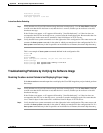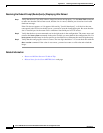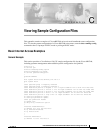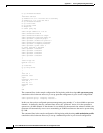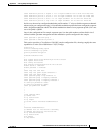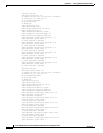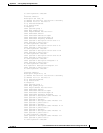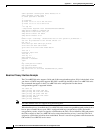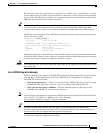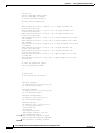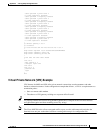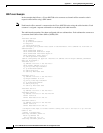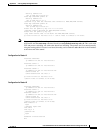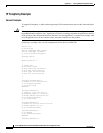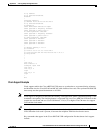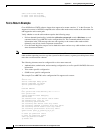
C-7
Cisco uBR7200 Series Universal Broadband Router Software Configuration Guide
OL-2239-03
AppendixC Viewing Sample Configuration Files
Keks and teks can be set to expire based on a gracetime or a lifetime value. A gracetime key is used to
assign a temporary key to a CM to access the network. A lifetime key is used to assign a more permanent
key to a CM. Each CM that has a lifetime key assigned will request a new lifetime key from the Cisco
uBR7200 series router before the current one expires.
Tip Use the show cable modem command to identify a CM with encryption/decryption enabled. The
online(pk) output of this command reveals a CM that is registered with BPI enabled and a KEK
assigned. The online(pt) output reveals a CM that is registered with BPI enabled and a TEK assigned.
Should you want to change the Cisco uBR7200 series default of 56-bit encryption/decryption to 40-bit,
use the “40-bit-des” option:
CMTS(config-if)#cable privacy ?
40-bit-des select 40 bit DES
^^^^^^^^^^
authenticate-modem turn on BPI modem authentication
authorize-multicast turn on BPI multicast authorization
kek KEK Key Parms
mandatory force privacy be mandatory
tek TEK Key Parms
Software then generates a 40-bit DES key, where the DES key that is generated and returned masks the
first 16-bits of the 56-bit key to zero in software. To return to 56-bit encryption/decryption after changing
to 40-bit, enter the no command preceding the “40-bit-des” option.
Caution Cisco uBR7200 series telco return images that support BPI, do not support encryption/decryption in the
telco return path.
Euro-DOCSIS Operation Example
The Cisco uBR7200 series supports Euro-DOCSIS channel plans when using the MC16E cable interface
line card. Key commands that appear in the Cisco uBR7200 series configuration file that denote
Euro-DOCSIS operation include:
• cable downstream annex A—Annex A is reserved for Euro-DOCSIS operations (Annex B is used
for DOCSIS NTSC operations). Annex A is chosen by default when using the MC16E.
• cable upstream 0 frequency <5008000>—The Euro-DOCSIS upstream valid range is from
5,000,000 to 65,000,000 Hz. You choose the value here.
Note The following Cisco IOS releases support Euro-DOCSIS operation using the MC16E cable interface line
card: 12.0(7)T, 12.0(7)XR2, 12.1 Mainline, 12.1(1a)T1 and higher;
SC train images including 12.0(8)SC, 12.0(9)SC, and higher.
Tip In contrast to other cable interface line cards where you set the downstream modulation and
interleave depth, the downstream interleave value is fixed for the MC16E and cannot be configured.
The MC16E also does not support enhanced spectrum management.
A sample Euro-DOCSIS configuration file follows:
!



